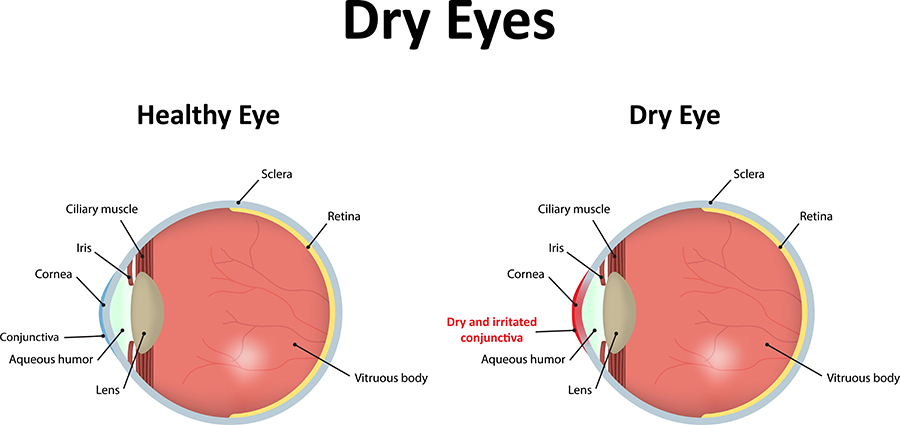To maintain optimal vision the eye must have a healthy tear film layer. Without adequate tears, the eye dries out causing discomfort and blurred vision. There are a number of conditions, both systemic (total body) and ocular, that are associated with the development of dry eye. There are also a number of treatments available for this potentially sight threatening condition.
The normal tear film is composed of three layers. A problem with the production of any one of these layers will cause dry eye symptoms. Before considering treatment options for dry eye, we will review several of the more common causes of dry eye.

Medications are a prime cause of dry eye because they can affect your total body chemistry. Antidepressants and allergy medications may produce or worsen a dry eye condition. If you develop the symptoms of dry eye, discuss your medications and allergies with your physician. If they are a possible cause and the symptoms are serious, together you might consider a change in medications.
Dry eye can also be caused by systemic conditions like Sjogrens Syndrome, Rheumatoid Arthritis or Sarcoidosis. Women who have passed through menopause are also susceptible to dry eye problems as their tear production is known to decrease with decreasing levels of estrogen. Improper closure of the eyelids can contribute to dry eye by allowing more rapid evaporation of the tear film. This can be a result of surgery on the lids or trauma. Irritation of the eyelids, allergies, certain home heating systems (forced hot air and wood stoves are examples) and even air conditioners can convert a mild dry eye into a symptomatic one.
Generally speaking, the first line of treatment for dry eye involves the use of non-prescription (over-the-counter) artificial tears. In some cases, non-preserved tears would be recommended if, for instance, the patient had a sensitivity to preservatives used in eye drops. These artificial tears come in a range of viscosity (thickness). The thicker solutions last longer but tend to blur the vision more and for longer time periods.
For patients in whom simple supplementation with artificial tears is not enough to control the symptoms, blocking the tear drainage system (“punctal occlusion”) can be performed by the eye doctor. This can be done with temporary, disolvable plugs, removable silicon plugs that do not dissolve (but can fall out) or permanently with surgical techniques.
Recently, a prescription strength drop to treat dry eye has become available. Although not indicated for all cases of dry eye (cost is a factor) it has shown great promise in the treatment of moderate to severe dry eye sufferers. In addition to supplementing the tear fluid, it acts as an anti-inflammatory agent, decreasing irritation which causes drying and damage to the ocular surface.
Dry eye is a very common condition with a wide range of severity. Contact lens use is particularly dependent on a healthy and plentiful tear film layer. Dry eyes can significantly complicate contact lens use and the clarity of your vision with the lenses. Patients are encouraged to discuss their dry eye concerns with their eye care professional.

 (603) 524-2020
(603) 524-2020 Order Contact Lenses
Order Contact Lenses Pay Your Bill Online
Pay Your Bill Online



